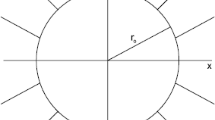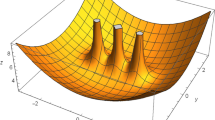Abstract
Two-charged bodiesM 1 andM 2 revolve round their centre of mass in circular orbits under Newton's inverse-square law and the so similar Coulomb's law. A third-charged-bodyM, without mass and charge (i.e., such that it is attracted or repulsed byM 1 andM 2, but does not influence their motion), moves in a field with a force function, namely
,
which is created byM 1 andM 2.
In what follows, the existence and location of the collinear and equilateral Lagrangian points or solutions with be discussed and the interpretation of them will be given. This work is a generalization of the classical restricted circular three-body problem.
Similar content being viewed by others
References
Dionysiou, D. D.: 1979,Nuovo Cimento 52B, 56.
Dionysiou, D. D. and Antonacopoulos, G.: 1981,Celes. Mech. 23, 109.
Luk'yanov, L. G.: 1984,Soviet Astron. 28 329.
Author information
Authors and Affiliations
Rights and permissions
About this article
Cite this article
Dionysiou, D.D., Vaiopoulos, D.A. On the restricted circular three-charged-body problem. Astrophys Space Sci 135, 253–260 (1987). https://doi.org/10.1007/BF00641560
Received:
Issue Date:
DOI: https://doi.org/10.1007/BF00641560




